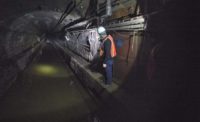The environmental impact statement for a new Hudson River crossing north of New York City is still in draft, but it will not include an expected mass transit component. With work on replacement spans for the Tappan Zee Bridge expected to begin as early as next fall, state officials say that they had to limit the current project's scope.
A plan to replace the deteriorating bridge has been debated for years. Carrying the New York State Thruway over the Hudson River north of New York City, the 56-year-old cantilever bridge required much costly maintenance to remain in service. An environmental review began in 2002 and considered everything from partially rebuilding the existing span to replacing it with a seven-mile-long tunnel beneath the Hudson.
The replacement plan for the renamed project, the Tappan Zee Hudson River Crossing Project, was one of 14 infrastructure projects that President Barack Obama tapped on Oct. 11 for expedited federal review. State officials expect federal agencies to approve the environmental review (EIS) within weeks of its submittal, possibly by early next year.
Before Obama's announcement, bridge replacement was part of a much larger project to rebuild and expand a 30-mile corridor of the New York State Thruway at an estimated cost of up to $16 billion. State officials could not figure out a way to pay for the corridor project, the bridge replacement and new transit components at this time, says Michael P. Anderson, project director for the New York Dept. of Transportation. State officials then limited the scope to $5.2 billion for replacement.
"It makes sense now to move forward with a bridge that is financially feasible and to replace a bridge that is functionally obsolete," says Joan McDonald, state transportation commissioner.
But the absense of mass transit surprised local residents. The scoping information packet released with the project's new notice of intent says the replacement's design "will not preclude transit," but any addition of commuter rail, light rail or bus rapid transit would have to be a separate project with a new EIS. Anderson cites several possible options, including building a third bridge dedicated to mass transit or a structure in the 46-ft gap between the two new bridges. Current plans call for two four-lane spans to replace the existing seven-lane bridge.
Anderson says the two potential designs to be examined in the EIS are long-span bridges with spans of 430 ft, and short-span bridges with spans of 230 ft. The long-span bridges would most likely be a steel-truss design and would require approximately 70 new piers in the river, while the short-span bridges would be concrete or steel and would require 118 new piers.
Anderson notes that "while construction is similar for the two options, timelines could be different depending on the amount of work in the river."
Bridges





Post a comment to this article
Report Abusive Comment